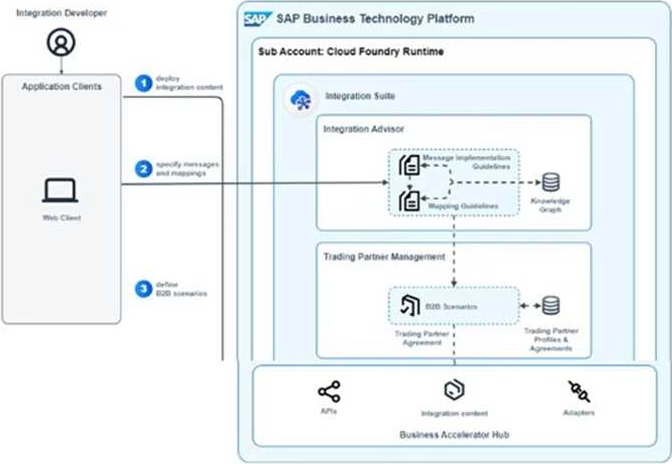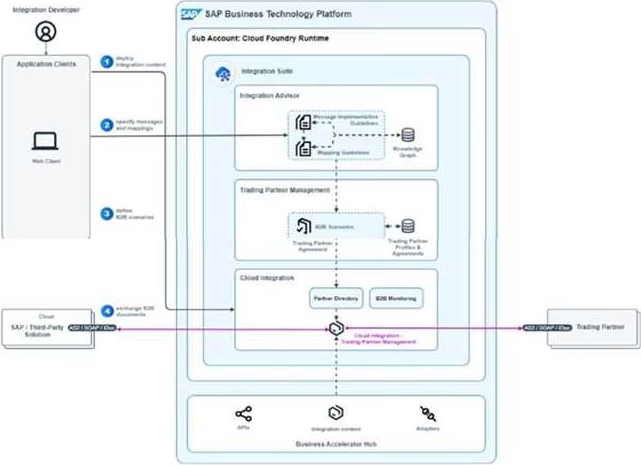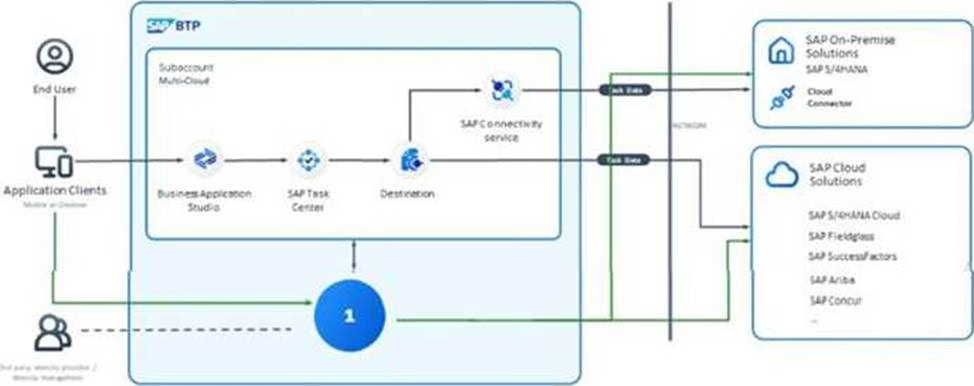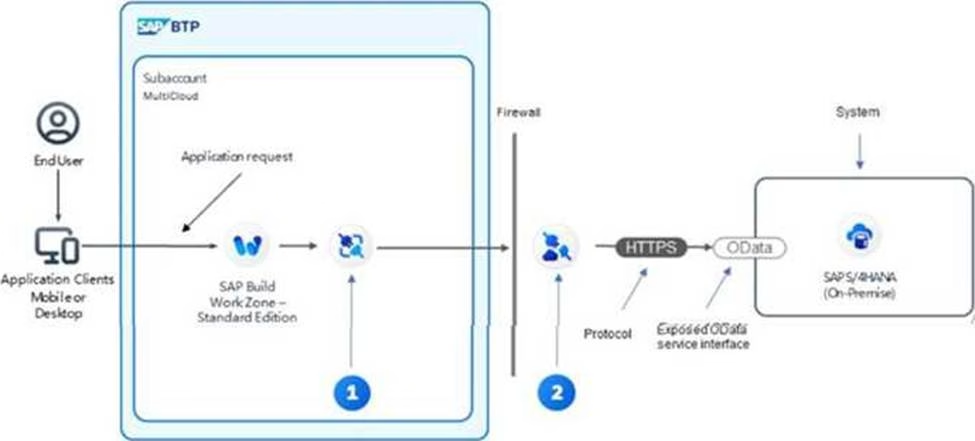SAP P_BTPA_2408 SAP Certified Professional – Solution Architect – SAP BTP Online Training
SAP P_BTPA_2408 Online Training
The questions for P_BTPA_2408 were last updated at Apr 09,2025.
- Exam Code: P_BTPA_2408
- Exam Name: SAP Certified Professional - Solution Architect - SAP BTP
- Certification Provider: SAP
- Latest update: Apr 09,2025
You are a solution architect on a brownfield project where an SAP ECC 6.0 system is being migrated to SAP S/4HANA Cloud public edition. Two mission- critical legacy applications must be migrated to the new system.
There is some debate on the project team as to the appropriate programming model to use:
• Application 1 was originally written using classic ABAP. The underlying SAP tables that the application originally relied on have been removed and the data now exists in a new simplified table in SAP S/4HANA Cloud public edition (to which table extensions are not permitted). Additional data needed for the application resides in SAP Ariba. Remote interfaces exist for both to select the data.
• Application 2 was originally written using Java and relied upon tables from the SAP ECC 6.0 system as well as SAP PLM 4.0. The PLM system will be retired; however, the SAP S/4HANA Cloud public edition instance has all the data needed for the application. No remote interfaces exist to select the data.
Which of the following approaches should the customer use? Note: There are 2 correct answers to this question.
- A . Rewrite application 2 using the Cloud Application Programming Model
- B . Rewrite application 1 using the Cloud Application Programming Model
- C . Rewrite application 2 using the ABAP RESTful Application Programming Model
- D . Rewrite application 1 using the ABAP RESTful Application Programming Model
In which phase of the SAP Integration Solution Advisory Methodology is a technology mapping of customer use cases and SAP BTP integration services produced (for an example of a solution architecture blueprint, see the attached diagram)?

- A . Enable a practice of empowerment
- B . Define integration best practices
- C . Design your hybrid integration platform
- D . Assess your integration strategy
A company is decommissioning its legacy ERP system in favor of adopting SAP solutions. The company is not sure which specific solutions to adopt.
The company has three main business goals:
• Maintain several unique business processes.
• Maintain the solutions with a small budget, and limited time and resources.
• Integrate several non-SAP solutions.
Which combination of solutions should the customer adopt?
- A . SAP Lean IX | SAP S/4HANA on premise | SAP BTP
- B . SAP Signavio | SAP S/4HANA public edition | SAP Process Orchestration
- C . SAP Signavio | SAP S/4HANA Cloud public edition | SAP BTP
- D . SAP Lean IX | SAP S/4HANA Cloud private edition | SAP Process Orchestration
A customer wants to verify the feasibility of the attached "proof of concept" design. They would prefer a zero (or minimal) upfront investment but want to seamlessly transition to a different pricing model while preserving their SAP BTP investments if the design works.

As a solution architect, which pricing plan would you recommend to the customer?
- A . Subscription
- B . Pay-As-You-Go for SAP BTP
- C . SAP BTPEA
- D . SAP BTP trial
You are a solution architect and your client has recently completed a merger and acquisition. Your client uses SAP S/4HANA Cloud Public Edition and the acquired company is using SAP ECC 6.0. For business and legal reasons, the users of the acquired company cannot yet be added to the global user directory. The acquired users still need access to the custom application.

Given the attached diagram, which solution would you recommend to your client in "1" to enable this access?
- A . SAP Cloud Identity Services – Identity Authentication
- B . SAP Cloud Identity Services – Identity Provisioning
- C . SAP Authorization and Trust Management Service
- D . SAP Secure Login Service for SAP GUI
As a solution architect, you are asked for your opinion on an optimal integration. You are told that the data resides in two places, SAP S/4HANA (on- premise) and third party APIs.
You are also told the following requirements:
• Periodically read the data from both systems, perform several transformations of the data, and forward the results to a business partner.
• Monitoring is to be done by a dedicated group from IT with SAP products.
• Maintenance of the integration part has a small budget, limited time, and limited resources.
Which of the following solutions would you recommend as optimal for the design?
- A . A custom SAP Fiori App and Grafana
- B . SAP Build Process Automation and SAP Solution Manager
- C . SAP Integration Suite and SAP Cloud ALM
- D . SAP Build Apps and SAP Cloud ALM
The customer is looking to use an SAP BTP service to replicate master data objects across connected business applications. The service should be based off of the process integration style and the integration use case pattern as defined in the SAP Integration Solution Advisory Methodology.
The customer wants to use an SAP BTP service to synchronize the workforce person master data object between SAP S/4HANA Cloud and SAP SuccessFactors HXM Suite as part of the Hire to Retire process (for cloud deployment). They prefer a service that uses a "hub and spoke" model to enable the synchronization.

Which of the following SAP solution should the customer use as the "Placeholder Icon" (see attached diagram)?
- A . SAP Master Data Integration
- B . SAP Master Data Governance
- C . SAP Cloud Integration
- D . SAP NetWeaver Master Data Management
A customer wants to establish connectivity between applications being executed by end users and the on-premise backend system (SAP S/4HANA).

Based on the attached diagram, which combination is necessary to establish the connectivity?
- A . Cloud Connector for 1 and Destination Service for 2
- B . Connectivity Service for 1 and Cloud Connector for 2
- C . Custom Connector for 1 and Connectivity Service for 2
- D . Destination Service for 1 and Connectivity Service for 2
Which part of the SAP Al architecture is responsible for providing the real-time, business-specific data to enable retrieval-augmented generation?
- A . SAP HANA Cloud vector engine
- B . SAP Joule
- C . Generative Al hub
- D . SAP AI Core
A manufacturer wants to discuss the design of a solution that tracks and manages stock availability
and movement of goods within a warehouse. They want to ensure that movements are aggregated for reporting purposes and that these reports can be used to optimize stock movements. They also want to use the newest solutions to build these reports.
Which of the following solutions can be used together to fulfill the requirements? Note: There are 3 correct answers to this question.
- A . SAP Data Intelligence
- B . SAP HANA Service (SAP Regions) for SAP BTP
- C . SAP Analytics Cloud
- D . SAP Datasphere
- E . SAP HANA Cloud
Latest P_BTPA_2408 Dumps Valid Version with 40 Q&As
Latest And Valid Q&A | Instant Download | Once Fail, Full Refund

